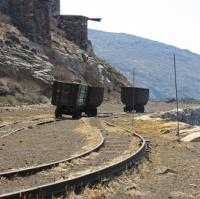
Readers will know that all of the major miners are currently aiming to divest assets as a way of bolstering their balance sheets. BHP managed to offload a stake in its emerging Jimblebar mine last week. But the two buyers were already joint-venture partners in the project.
Since then we have had confirmation that Fortescue has been unable to offload its power assets and today Rio Tinto has shelved the sale of its $US2 billion-plus diamond division:
Rio’s diamonds division had been slated for possible sale since March 2012 under the code name Project Aurora.
However, Rio diamonds and minerals chief executive Alan Davies said that following a strategic review of the business, the medium to long term fundamentals for diamonds remained “robust” underpinned by growing demand for luxury goods in Asia and strong demand in North America.
“After considering a number of alternative strategic ownership options it is clear the best path to generate maximum value for our shareholders is to retain these businesses,” Mr Davies said.
Yada, yada, yada. In other words, nobody wanted to buy it. And that’s the issue right now. It’s not a great look for all these miners to have so massively invested all at once and now suddenly be turning around and selling assets simultaneously too. They’ve created a buyer’s market. And don’t want to buy each other’s assets.
There are potential buyers of course, as Gotti wrote last week that:
Today I want to introduce you to where private equity investors expect to make their next big killing – coal mining.
And if they achieve their goals, it will show how coal mining can prosper using different management techniques plus independent contracting. It will go a long way to reshaping large segments of the Australian economy. No change in industrial relations laws are required but a change of government would also help.
Although they do not plan to engage in this area, some of the backers of coal proposal believe similar techniques would transform the operation of General Motors and what’s left of the old food processors.
Queensland has some of the richest and best coal reserves in the world but its mines are shutting and a great many are losing money. The private equity investors have closely examined many big Queensland mines and are staggered at how the coal boom generated bad management practices by the major mining companies and even some of the smaller ones.
They believe that the operating costs of most mines can be reduced by between 35 and 40 per cent without too much difficulty. That totally transforms the economics of many operations. The scope to slash costs is illustrated by the graph below, which shows how badly Australian mine management has performed.
This is potentially smart thinking and I’ve no doubt whatsoever that the boom produced more than its fair share of inefficiencies. But I’m sure as well that private equity realises that the longer it waits the cheaper these assets will get. TThe pain has just begun in coal and iron ore. The time to buy is the same as it is for potential shareholders, when blood is flowing in the gullies of the Bowen Basin and Pilbara and the dollar plunging to 70 cents. It’s a year away still by my guess.

